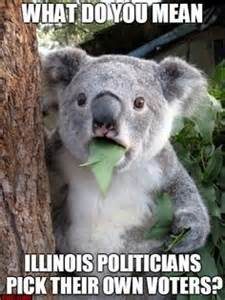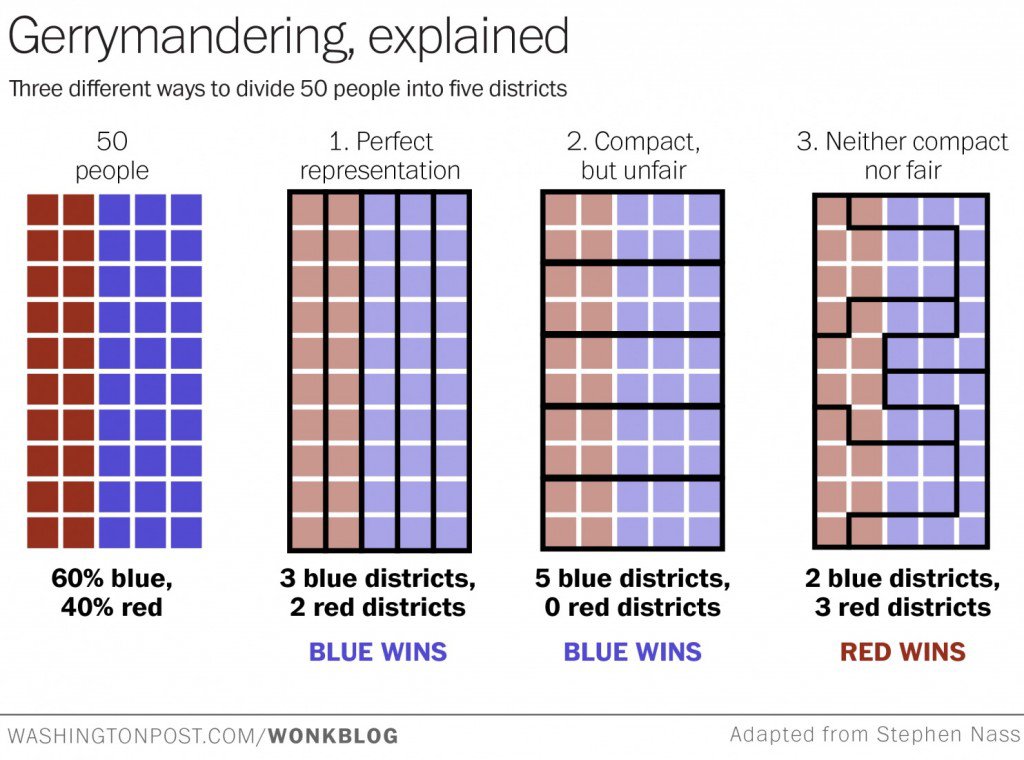Purposely sending immigrants to one CD or another to enhance or alter dominant party control
 Per the Constitution, every ten years, the U.S. conducts a census. The next one will be taken in 2020. Using the results, representatives to the U.S. house will be reapportioned, reflecting population shifts. At that time, state legislatures and governors will re-draw congressional boundary lines.
Per the Constitution, every ten years, the U.S. conducts a census. The next one will be taken in 2020. Using the results, representatives to the U.S. house will be reapportioned, reflecting population shifts. At that time, state legislatures and governors will re-draw congressional boundary lines.
With the size of the U.S. House of Representatives set at 435 after each census the apportionment of those seats nationally takes place. The balancing results in some states losing a seat or two and other states gaining a seat or two. The congressional districts within any state must be balanced according to population. An example would be: A state with 10 representatives and 1 million population would have 100,000 people in each district. There have been some court rulings protecting minority franchise, but exactly how those district lines can be drawn is murky.
A local example might be Illinois’ 17th congressional district. It encompasses all or parts of 13 counties. Prior to the 2010 census, it snaked from Sterling, west to Moline, south past Quincy, over to Springfield, ending in Decatur. Reliably democrat for years, it evolved until a Republican won in 2010. Illinois’ population fell during that decade, losing 1 congressman. With Democrats controlling the state, the district was re-drawn (re-gerrymandered), once again majority Democrat.
With the 2020 census looming, and population shifting south and west, there is likely to be a number of congressional seats moving from the “rust belt” to the “sun belt”. Of course this will trigger states to re-draw their districts. The importance of controlling state legislatures and governors’ mansions increases around a census.
Watching coverage on election night, I was amazed to see how quickly and easily voter info and trends are accessed. In this computer age, gerrymandering can be fine tuned. It will go from an art to a science.
Currently Republicans have a large advantage in governorships and state legislatures. Logically they should gain further advantage in the U.S. house after 2020.
OK, tell me something I don’t know.
What if a new kind of gerrymandering could be invented? What if, instead of drawing lines around voters, voters could be moved into the existing lines?
Ex-President Obama’s obsession with allowing unfettered illegal immigration, encouragement of the “unaccompanied minors” flood, and insistence on importing refugees from the middle east has always baffled me. The issue’s a loser with average white voters, and harms low skilled black workers disproportionately. Very strange.
It has always taken immigrant groups a period of time to disperse and assimilate into society. Initially they congregate in enclaves. From Somalis in Minnesota’s twin cities, to middle easterners in Dearborn, to Hispanics in Moline’s Floreciente neighborhood. Segregated to some extent, voting as a bloc.
Could a targeted dispersal of refugees to key areas of the country have the result of changing the partisan makeup of districts with razor-thin margins?
This theory would require a long-term view, something few of our short-sighted politicians possess. I do not have access to information on where all these “unaccompanied minors” and refugees are being settled. It is pure speculation on my part. Could what I’d call “reverse gerrymandering” work? Work? Hell, I can’t even say it exists.
But… as Judge Judy says, “If it doesn’t make sense, it’s not true.” I held that phrase up to a mirror and it became this: “If it makes sense it is true” I don’t want to be the guy in the tin foil hat, but “reverse gerrymandering kind of makes sense. At least to me.
Just a thought for pondering.
Eugene Mattecheck Jr.
Related reading:
Daily Koss (need to know what the enemy thinks) Which states will gain seats in Congress come 2020, and which will lose? Here’s a very early look
UNC Carolina Demography 2020 Reapportionment Will Shift Political Power South and West
University of Virginia Center for Politics; Sabato’s Crystal Ball Updated 2020 Reapportionment Projections

This WaPo graphic is only appropriate to an extent. It presumes two-party system. The panel on the right demonstrates manipulations possible if state law allows such “discretion” and if blocks are taken to mean some sort of political subdivision, usually precincts. But keep in mind that a “blue” or “red” precinct is often a blue or red shade of purple. And, at some point “walk the plank” and “dummymander” concepts can come into play (exemplified in the Daily Kos article referenced above). The panels have a never experienced precept of pureness and no non-party voters. The latter do give up influence by not being part of the organizing of the system, perhaps even as a third-party that has to be bargained with. Representing option 1 (2nd panel from left) as “perfect” is not a word to be used. It is only an option. Reasonable compactness is appropriate and option 1 does not provide that. Another problem with claiming it represents perfection is that in the real world the individual boundaries are manipulable or arguably “unfair” or unrepresentative to start. Perhaps the percentage of divergence from the average allowed now (constituents per Congressman) could be loosened up a bit to allow for other virtuous goals of redistricting. The “one-man-one-vote” virtue to still primarily control. R Mall
